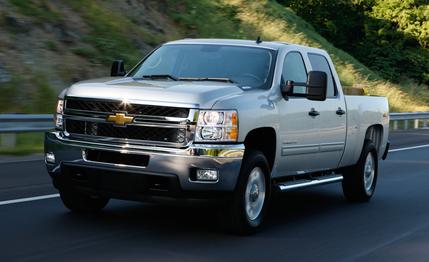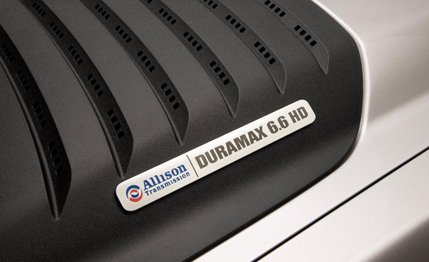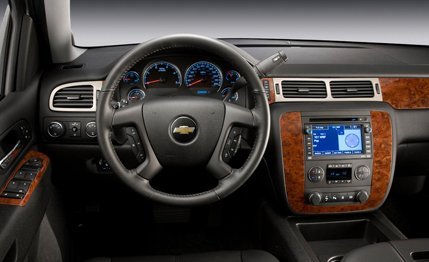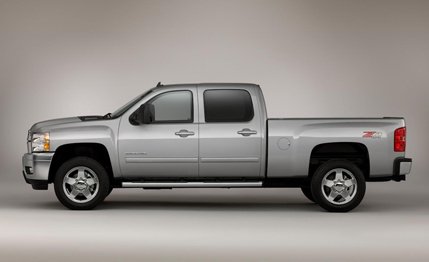
 Short Take Road Test
Short Take Road Test


With more than a million annual sales at stake—very profitable sales, at that—as well as bragging rights for who can move the largest mountain, the rivalries in the full-size-truck segment are some of the hottest in the automotive world. Nowhere is this more true than in the heavy-duty sector, which for 2011 sees the freshened Chevrolet Silverado HD and its GMC Sierra HD twin locking horns with a new Ford F-series Super Duty. Yet despite Ford’s claim to the title of most-powerful diesel engine—its 6.7-liter turbo-diesel V-8 was updated in mid-2010 to a nice, round 400 hp and 800 lb-ft of torque—the GMC Sierra 2500HD Denali crew cab handily outpaced a similar F-250 at our test track. Shocked by the performance of GMC’s big boy, we had to take a look at a blue-collar Chevrolet Silverado 2500HD.
Dropping the Hammer
We say “blue collar” because GM positions the GMC as a slightly more upscale product, despite the trucks being mechanically identical and distinguished only by different trim. Both models start at $28,960 for a rear-drive, standard-cab work truck, but there’s nothing blue-collar about the $60,000-plus limit for a fully loaded crew cab, four-wheel-drive diesel version of the GMC or Chevy. Like the heavy-duty Denali, our 4x4 Silverado 2500HD crew cab was powered by the revised-for-2011 6.6-liter Duramax turbo-diesel V-8, which is backed by an Allison six-speed automatic transmission. The powertrain costs $8395. We highly recommend it and its 397 hp and 765 lb-ft of torque.


This Chevy also had 260 fewer pounds to lug around than did the last 4x4 F-250 crew-cab diesel we tested—7580 pounds for the Silverado versus 7840 for the Ford. As a result, the 3.8-ton Silverado stormed to 60 mph in 7.1 seconds and through the quarter-mile in 15.5 seconds at 88 mph. These figures are respectable for a normal car but downright astounding for a vehicle this large; the numbers humble the F-250 by 0.8 and 0.5 second, respectively, and even top the Denali HD’s times by a couple 10ths.
With optional 20-inch alloys, Goodyear Wrangler all-terrain rubber, and 4540 pounds over the front axle, the Silverado rounded the skidpad at 0.73 g and stopped from 70 mph in 202 feet. In our test results, the Ford only topped the GM in the sound-level evaluation, where it was noticeably quieter than the Chevy in all circumstances.
Pounding the Pavement
On the road, the height of the Silverado’s helm greatly disconnects you from the feeling of speed. The mountain of torque allows surprisingly quick passing, and the truck hits its 97-mph governor well before your butt thinks it should. The Duramax V-8’s variable-geometry turbo doesn’t spool up as quickly as the Ford’s, which sports a unique dual-compressor-wheel construction for quicker responses. GM’s Allison transmission, however, is well matched to the strong-pulling engine, helping to mitigate the greater turbo lag. The EPA doesn’t provide fuel-economy ratings for vehicles in this class, but we managed 14 mpg over 600 or so miles of commuting.
Also new for 2011 is an exhaust brake, which uses the engine’s compression to slow the vehicle and is activated by a switch on the dash. Used primarily to save the brakes when towing, it also works when the truck is unloaded. It fails, however, to emit the blaring overrun of a semi careening down a steep grade, and for that our neighbors thank us.
Without a spare Ford Fiesta to throw into the bed or a Caterpillar to drag around, we weren’t able to test the Chevy’s 2792-pound payload and 16,700-pound tow limits. Like all these heavy haulers, it rode a little choppy when empty. The independent front suspension—unique to GM’s HD trucks—has been fortified for 2011, as has the rest of the chassis, and it lends a more responsive feeling than the solid axles of the Ford and the Dodge Ram. It’s still stiff and easily upset over large bumps, but it helps to produce probably the most responsive steering in the segment. Despite its towering height, 20-foot length, and considerable mass, the Silverado HD drives noticeably smaller and with greater agility than its competitors.
Old Duds
Although all modern HD trucks are about the same size, the GMs feel smaller overall and are the easiest to climb into and out of. It’s when you are inside that the Chevy—and the GMC—fall short. The Silverado’s cabin hasn’t been updated in a while and is dominated by hard, chintzy plastic, with seemingly little thought having gone into its design. There is no high-def information screen in the gauge cluster as in the newest Fords, and the infotainment system’s graphics look to be of Windows 98 vintage.


The exterior styling, although well proportioned and devoid of the Sierra Denali HD’s chrome overload, also looks a bit dated. The 2011 models do get new hoods, bumpers, and grilles—along with the available 20s—but it’s not all that noticeable. GM says it focused on the HD’s dirty bits this time around and will update the aesthetic elements in a couple years when it revises the light-duty Silverado and Sierra. That makes sense, but it still seems like something more could have been done.
How Dear Is That Power?
At an as-tested $60,215 ($54,035 base, including the Duramax/Allison combo), our leather-and-faux-wood-trimmed Silverado LTZ crew cab was about as nice a truck as Chevy sells and as pricey as the high-end Sierra Denali HD. In addition to the $8395 diesel powertrain, the window sticker swelled with the touchscreen navigation system ($2250), a power sunroof ($995), the aforementioned 20-inch wheels ($850), a rearview camera ($450), curtain airbags ($395), the Z71 off-road package ($275), and various other luxuries and add-ons.
And so, like we said, this particular Chevy ended up being as much an everyday, blue-collar truck as a Bentley wagon is an everyday, blue-collar family vehicle. But that doesn’t make it any less good, and there’s something captivating about feeling this much mass hurl itself down the road with such ease. In the truck world, however, loyal Ford buyers don’t care about the Silverado’s performance any more than GM drivers care about the Super Duty’s advantage on paper. This round goes to GM, but we doubt Ford will let the rivalry end here.

